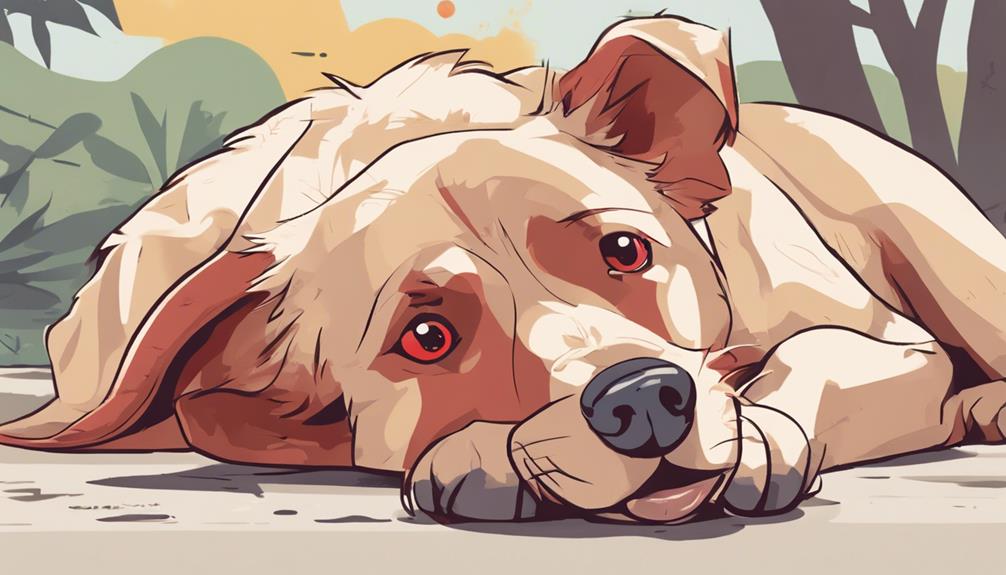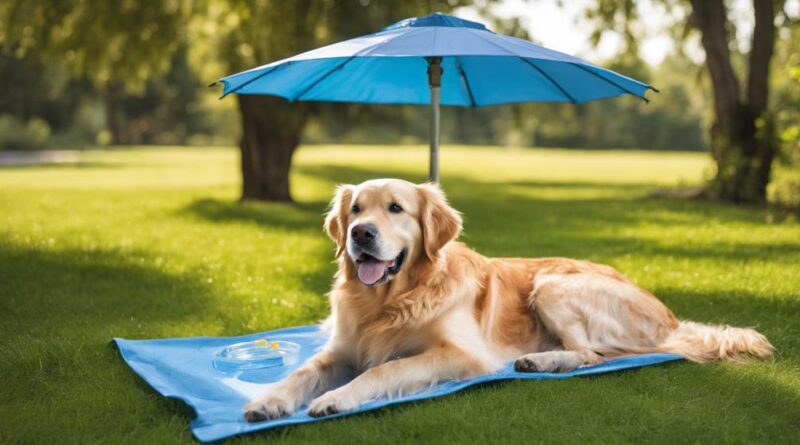Summer Dog Care Tips for Hot Climates
Imagine your furry friend as a delicate flower in the scorching summer sun; taking care of them requires diligence and attention to detail.
As the temperatures rise, ensuring your canine companion stays safe and comfortable becomes paramount. But how can you protect your pooch from the heat without missing any crucial steps?
Let's explore some essential tips for summer dog care in hot climates to keep your four-legged buddy happy and healthy all season long.
Providing Adequate Hydration
To ensure your dog stays healthy during the summer months, make sure they have access to plenty of fresh water throughout the day. Keep their water bowl filled with cool, clean water at all times to prevent dehydration. Dogs can easily overheat in hot weather, so it's crucial to provide them with constant hydration.
Another great way to help your furry friend beat the heat is by offering them frozen treats. You can make simple yet delicious treats by freezing fruits like strawberries or blueberries in ice cubes. Not only will these treats help keep your dog cool, but they also provide a tasty snack that's full of nutrients.
Protecting Paw Pads From Hot Surfaces
Make sure your dog's paws are protected from hot surfaces during the summer by being mindful of where they walk and avoiding pavement or sidewalks that can get scorching hot. Here are some tips to help safeguard your furry friend's paw pads:
- Plan walks during cooler times: Schedule your walks during the early morning or late evening when the pavement is less likely to be hot.
- Use protective booties: Consider using dog booties to shield your pet's paws from the heat. Make sure the booties fit properly and are comfortable for your dog to wear.
- Test the pavement: Before heading out, touch the pavement with your hand. If it's too hot for your hand, it's too hot for your dog's paws.
- Stay on grassy areas: Opt for grassy or shaded paths for walks to prevent your dog's paws from burning on hot surfaces.
Offering Cooling Treats and Toys
Keep your furry friend cool and entertained during the summer by providing refreshing treats and toys. Frozen snacks are a great way to help your dog beat the heat. You can make simple frozen treats by filling a Kong toy with peanut butter or yogurt and freezing it. Another option is to freeze small portions of fruits like berries or watermelon for a tasty and hydrating snack.
Water games are another fantastic way to keep your pup cool and active. Consider setting up a kiddie pool in your yard for your dog to splash around in. You can also engage them in games like water fetch by throwing a toy into shallow water for them to retrieve. Not only will this help them cool down, but it will also provide them with exercise and mental stimulation.
Avoiding Midday Walks
During the hot summer months, it's best to schedule your dog walks in the early morning or late evening to avoid the peak heat of the day. Walking during cooler times can prevent your furry friend from overheating and burning their paws on scorching pavement. To ensure your dog stays safe and comfortable, consider the following tips:
- Early morning walks, evening strolls: Opt for walks during these times to prevent your dog from being exposed to extreme temperatures.
- Indoor playtime, backyard fun: Engage your dog in indoor activities or play in the shaded areas of your backyard to keep them active without risking heat exhaustion.
- Hydration breaks: Always carry water for your dog during walks and offer frequent breaks to keep them hydrated.
- Watch for signs of heat stress: Be vigilant for symptoms like excessive panting, drooling, or weakness, and seek shade immediately if your dog displays these signs.
Providing Access to Shade
To ensure your dog stays cool and protected from the sun's intense rays, it's important to provide access to shaded areas during outdoor activities. When spending time outside with your furry friend in hot climates, seek out spots with ample tree coverage or consider setting up outdoor shelters like umbrellas or tents.
These shaded areas can offer relief from the direct sunlight and help prevent your dog from overheating. Trees not only provide natural shade but also aid in cooling the surrounding air, creating a more comfortable environment for your pup to relax in. Outdoor shelters, such as pop-up tents or designated shaded areas in your yard, serve as safe havens where your dog can retreat to when the sun becomes too intense.
Using Dog-Friendly Sunscreen
For effective protection against the sun's harmful rays, consider using sunscreen specifically formulated for dogs. When it comes to canine sun protection, taking the necessary steps can prevent sunburns and reduce the risk of skin cancer in your furry friend.
Here are some essential tips for using dog-friendly sunscreen:
- Choose a Pet-Safe Sunscreen: Ensure the sunscreen you select is labeled as safe for use on dogs to avoid any potential skin irritations.
- Apply Sunscreen to Vulnerable Areas: Focus on areas with thin or no fur such as the nose, ears, belly, and groin where the skin is more exposed.
- Reapply Regularly: Remember to reapply sunscreen every 4-6 hours, especially if your dog is swimming or sweating.
- Avoid Zinc Oxide and Fragrances: Steer clear of sunscreens containing zinc oxide and fragrances as they can be harmful if ingested or cause skin reactions.
Monitoring Signs of Heatstroke

After ensuring your dog is protected with dog-friendly sunscreen, it's crucial to monitor signs of heatstroke during the hot summer months. Recognizing symptoms of heatstroke in dogs is vital for prompt intervention.
Watch out for excessive panting, drooling, rapid heartbeat, red gums, vomiting, diarrhea, and weakness. If your furry friend displays any of these signs, immediate treatment is necessary.
Move your dog to a cool, shaded area, offer small amounts of water to drink, and place a cool towel on their body. Avoid using ice-cold water as it can constrict blood vessels and hinder heat dissipation. Contact your veterinarian promptly for further guidance.
Adjusting Exercise Routine
Consider adjusting your dog's exercise routine to ensure they stay safe and comfortable during the hot summer months. Here are four tips to help you keep your furry friend active without overheating:
- Indoor play: Opt for indoor activities like hide-and-seek, tug-of-war, or interactive toys to keep your dog entertained while staying cool in the air-conditioned environment.
- Water activities: Introduce water play to your dog's routine by setting up a kiddie pool in the shade or taking them to a dog-friendly beach or lake. Swimming is a great low-impact exercise that helps your dog stay refreshed.
- Morning or evening walks: Schedule your dog's walks during the cooler parts of the day, such as early morning or late evening, to avoid the scorching midday sun.
- Shorter but more frequent outings: Instead of long and intense exercise sessions, break them into shorter but more frequent outings to prevent your dog from getting too hot and exhausted.
Frequently Asked Questions
Can I Apply Regular Sunscreen on My Dog to Protect Them From the Sun?
You shouldn't apply regular sunscreen on your dog as it can be toxic if ingested. Instead, opt for pet safe sunscreen alternatives specifically made for dogs to protect them from the sun's harmful rays.
Additionally, consider using cooling vests for dogs to help keep them cool and comfortable during hot summer days. It's important to prioritize your furry friend's safety and well-being when it comes to sun protection.
How Often Should I Check My Dog for Signs of Heatstroke During the Summer?
You should check your dog for signs of heatstroke frequently during the summer. Keep an eye on panting, excessive drooling, and weakness.
Make sure to provide hydration reminders and offer shade options. If you notice any symptoms, move your dog to a cool area, offer water, and contact your vet immediately.
Prevention is key, so be proactive in keeping your furry friend safe from heat-related issues.
Are There Any Specific Breeds That Are More Prone to Overheating in Hot Climates?
Certain dog breeds, like Bulldogs and Pugs, are more prone to overheating in hot climates. It's important to take breed-specific precautions to keep them safe.
Be sure to provide cooling techniques such as access to shade, fresh water, and even cooling mats.
Watch out for signs of heatstroke, especially in these breeds, and act promptly to prevent any serious health issues.
Keeping them cool is key to their well-being in the summer heat.
Is It Safe to Take My Dog to the Beach During the Summer Months?
It's safe to take your dog to the beach during the summer months as long as you prioritize beach safety and hydration. Make sure your furry friend has access to fresh water to stay hydrated.
Protect your pet from the sun by providing shade and using pet-safe sunscreen. Take precautions to prevent overheating by providing breaks in the shade and monitoring your dog for signs of heat exhaustion.
What Are Some Signs That My Dog May Be Experiencing Discomfort From the Heat, Other Than Panting Excessively?
If your dog seems restless, drools more than usual, or has red gums, they may be struggling with the heat. Keep an eye out for these signs, especially if you're out and about in the sun.
Make sure they've enough water and access to shady spots. Consider using cooling products like mats or vests.
Adjust exercise intensity to prevent overheating, and always prioritize hydration levels in hot weather.
Conclusion
Overall, taking care of your dog in hot climates requires vigilance and proactive measures. By ensuring they've access to water, shade, and protection from hot surfaces, you can help keep them comfortable and safe during the summer months.
Remember to monitor their behavior for signs of heatstroke and adjust their exercise routine accordingly. With these simple tips, you can help your furry friend enjoy the summer while staying cool and healthy.
